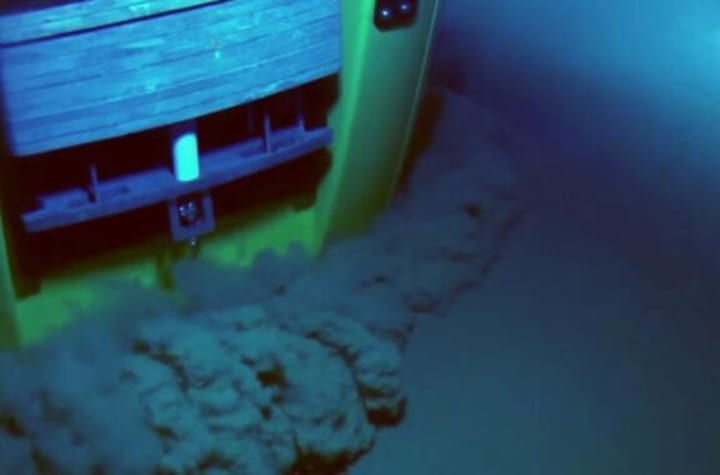The deepest seafloor has a pressure of over 1000 atmospheres, will the mud here be compressed?
Strong pressure in the deep sea

About 71% of the Earth's surface is covered by the oceans, and we humans know very little about this vast area. As things stand now, human activity in the oceans covers only about 5% of the entire ocean water column. Why is this so? This is because for every 10 meters increase in the depth of the ocean, the pressure in the seawater will increase by about one atmosphere, while the average depth of the Earth's oceans is about 3795 meters, so it can be said that it is the strong pressure in the deep ocean that limits the ability of humans to explore the ocean.
Earth's oceans vary in depth, and the deepest known ocean is located in the Mariana Trench (Mariana Trench) near the Mariana Islands in the Pacific Ocean. Although humans are not yet able to accurately measure the depth of the Mariana Trench, the depth of the Mariana Trench is certainly more than 10,000 meters, which means that, based on the above relationship between water depth and pressure, we can conclude that The deepest known depth of the Earth's seafloor has a pressure of more than 1000 atmospheres.
What is the concept of this pressure? This is equivalent to a square centimetre will be subjected to more than 1 ton of weight, so the question arises, since the Marianas Trench pressure is so large, then the soil here will be pressed into what kind of shape?
After the heavy roller is pressed, the original loose ground material will be compacted by the roller, thus becoming relatively flat and strong, which is a common scene we see. And the general roller is a dozen tons, and the contact area between its grinding wheel and the ground is usually more than 1 square meter, a little analysis, we will find that the pressure generated by the roller simply can not be compared with the deepest seabed of the Earth, so by this reasoning, the Marianas Trench where the soil will not be pressed very tightly?
Otherwise, the reason why the roller is able to press the ground material very tight is not that it compresses the micro structure of the ground material, but because the pressure generated by the roller compresses the voids between the ground material, these voids would have been filled with air, when the roller rolls over, this air either escapes from the side of the crushing surface, or is compressed (air is easily compressed).

The mud of the seafloor is a deposit produced by a combination of physical, chemical, and biological effects (e.g., the remains of marine organisms and their decomposition, various mineral deposits, volcanic materials, and even dust from the universe). Although the composition of the mud under the sea is very complex, but they all have one thing in common, that is, their structure is loose, and there are many gaps between the various substances inside them, but the gaps within the mud here are not compressed.
This is because, in the ocean, the material that exists in the internal void of the submarine mud is not air, but the seawater that permeates it, because the medium that transmits pressure in the ocean is seawater, and the pressure that is transmitted in all directions is equal, which means that there is equal pressure inside and outside of the mud so that the internal void of the submarine mud will not be compressed, even if the deepest seafloor pressure is more than 1000 atmospheres, the mud here will not be compressed.
In the video about the underwater world, we can often see some creatures living on the sea floor, these creatures for some purpose (such as depredation, camouflage, etc.), will often drill in and out of the mud on the sea floor, and appear to be effortless, which shows that the mud on the sea floor is very loose.
Some people may say, those videos of the sea floor are only very shallow waters, while the depth of the Marianas Trench is more than 10,000 meters, the pressure of more than 1,000 atmospheres, in such a large pressure, who knows what the mud here will be pressed, perhaps the mud here will be very tight may not be said. Well, let's look at one more piece of evidence.
On March 26, 2012, the famous director James Cameron. Cameron (James Cameron) realized his dream, once alone in the "Deep sea Challenger" deep-sea submersible (by the way, the submersible is tailor-made for him) successfully reached the bottom of the Marianas Trench area, it is reported that he dived into a depth of 10,898 meters, creating a deep-sea The world record for a single person dive.
The above picture is the scene when the Deep sea Challenger touched the bottom, we can clearly see that a large amount of loose mud was lifted from the bottom of Deep sea Challenger, which is strong proof that the mud at the bottom of the Marianas Trench is also loose The mud at the bottom of the Marianas Trench is also loose material, and it is not compressed by a pressure of more than 1000 atmospheres.
About the Creator
Carlo Phil
Science and art are two sides of a coin






Comments
There are no comments for this story
Be the first to respond and start the conversation.